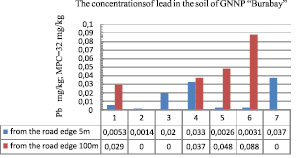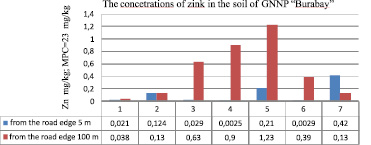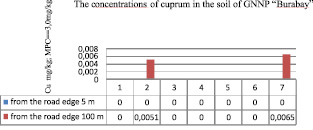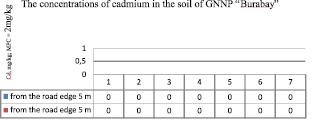Active human activities are constantly causing some damage to the environment. Waste of economic activity pollutes air basin, water sources and soil. All this causes environmental problems [5, 8].
The main sources of contamination of soils and plants are the major cities, towns with their industrial emissions and waste production, irregular use of the agricultural production of various agrochemicals, as well as all the modern means of transportation (air, rail, sea and road). Among the many environmental pollutants heavy metals (HM) is considered to be the most dangerous – they conditionally include chemical elements with atomic mass greater than 50, with the properties of metals or metalloids.[5, 2, 3, 7].
Automotive pollution is one of the most dangerous, providing a hard impact on the roadside ecosystem. In the exhaust gas there detected more than 200 different substances, among which only five are non-toxic. Pollution of soils in the largest quantities of lead, cadmium and zinc is connected with the work of road transport [1, 2, 3, 3, 4, 8].
The purpose of the study is an environmental assessment of heavy metals in the soil Governmental National Park «Burabai».
The scientific novelty of this work are the first time there did determination of heavy metals in the soil – a group of plants roadside and it increasing flow of tourists, respectively, and vehicles, enhances human pressure on the ecosystem of the resort. Of particular concern to the risk taken by the pollution of protected areas with heavy metals, particularly lead.
In a fine place of the northern region of Kazakhstan in Akmolinsky region the State national natural park «Burabay» is located. It is organized on August 12, 2000 by the Government resolution. Burabay is known to the world as geographical point with seldom meeting nature. Burabay is the low mountain district a part of small peaks of Kazakhs [9, 10].
At the present stage the total area of national park is 83510 hectares of the land from which 47,4 thousand hectares of the area are covered with the wood. The National park is nature protection public institution, it is included into system at Administration of the President of the Republic of Kazakhstan and especially protected natural territory of republican value [9, 10].
Main objectives of National park «Burabay»:
– research and preservation of integrity of the ecosystem, etalon and especially natural complexes and objects, historical and cultural monuments, and also other objects;
– restoration of the destroyed natural and cultural and historical complexes and objects [9, 10].
Samples of the soil plants were taken in the summer of 2011 on a bypass road of a resort zone from the following points: sanatorium «Shchuchinsk», exhibition platform, platform of Abylay khan, station Kayyk, market Bereke, sanatorium «Baldauren», Okzhetpes. As the biggest autostream on a resort zone passes on this route.
Soil. Determination of a mass fraction of concentration of cadmium, lead, zinc and copper by means of an inverse voltaperometric method.
– It is certified according to State obligatory standard 8.563-96.
– Certification was carried out by theoretical and experimental results of a technique of performance of researches.
Samples of the soil were taken from the chosen seven points. In this picture it is shown lead concentration in soil samples of SNNP «Burabay».
Indicators of lead in the contents of the soil
Results of research of the soil showed that lead didn’t exceed MPC. Its most large quantity was noticed in places of the main flow of tourists in sanatorium «Baldauren» (0,088 mg/kg), on a market Bereke in the settlement Burabay (0,048 mg/kg), at station Kayyk (0,037 mg/kg).
Indicator of zinc in the contents of the soil
Zinc. The most admissible quantity of zinc makes 1 mg/kg from the weight of a body. Zinc in the form of salts and organic compounds is contained in all types of food. Its share in composition of natural waters doesn’t exceed 0,05 mg/l. The high concentration of zinc salts in the contents of natural water leads to organism poisoning.
On the following picture the share of zinc concentration in the soil is given. Samples of the soil were taken from two sides of the road of the chosen seven points at distance of 5 and 100 meters.

Fig. 1. Indicator of lead in the contents of the soil of SNNP «Burabay», 2011, MPC = 32 mg/kg: 1 – sanatorium «Shchuchinsk»; 2 – an exhibition platform; 3 – a platform of Abylay khan; 4 – station Kayyk; 5 – market Bereke; 6 – sanatorium «Baldauren»; 7 – area of the mountain Okzhetpes

Fig. 2. The share of zinc concentration in the contents of the soil of SNNP «Burabay», 2011, MPC = 23 mg/kg: 1 – sanatorium «Shchuchinsk»; 2 – an exhibition platform; 3 – a platform of Abylay khan; 4 – station Kayyk; 5 – market Bereke; 6 – sanatorium «Baldauren»; 7 – area of the mountain Okzhetpes
In all taken soil samples research results in all researched zinc samples zinc was found however MPC of zinc wasn’t exceeded. The high concentration of zinc was revealed around a market «Bereke» (1,23 mg/kg) in 100 meters, around station Kayyk (0,9) in 100 m, around a platform of Abylay khan (0,63) in 100 meters. At distance of 5 meters from the road the high concentration of zinc was found near the mountain Okzhetpes (0,42 mg/kg) and the market «Bereke» (0,21).
Cuprum and cadmium indicator in the soil
Cuprum. In small quantity is found in zinc concentrate also can overcome long distances by means of air and water. Salts of copper belong to the II class of danger. Poisoning properties of cuprum in comparison with other elements are a little investigated.
On the following scheme concentration of copper is shown.
By results of research of samples of the soil it was revealed that concentration of copper doesn’t exceed MPC and its concentration is revealed only in two points: exhibition platform (0,0051 mg/kg) and mountain area Okzhetpes (0,0065 mg/kg).

Fig. 3. Indicator of cuprum in the contents of the soil of SNNP «Burabay», 2011, MPC = 3,0 mg/kg: 1 – sanatorium «Shchuchinsk»; 2 – an exhibition platform; 3 – a platform of Abylay khan; 4 – station Kayyk; 5 – market Bereke; 6 – sanatorium «Baldauren»; 7 – area of the mountain Okzhetpes

Fig. 4. Indicator of cuprum in the contents of the soil of SNNP «Burabay», 2011, MPC = 2 mg/kg. Cadmium. It is compared to a time bomb. Cadmium in a human body gathers in kidneys, and causes illness
By results of research cadmium wasn’t found in the contents of the soil.
Indicators of heavy metals in contents of grassy plant. The general indicators of heavy metals in the contents of the grassy plants of SNNP «Burabay» can be seen on the following table (Table 1). From the table it is possible to notice high concentration of zinc in all points.
Samples of grassy plants were taken from the «Golden Ring» highway of SNNP «Burabay» at distance of 5 and 100 meters from the road from the chosen points.
Lead indicator in contents of grassy plants. At research on lead concentration in the contents of samples of plants it was revealed that lead doesn’t exceed MPC. MPC = 0,5 mg/kg. By results of research high concentration of lead was revealed around sanatorium «Shchuchinsk» – 0,031 mg/kg, around an exhibition platform – 0,029 mg/kg.
Zinc indicator in grassy plants. As a result of research concentration of zinc doesn’t exceed MPC. MPC = 10,0 mg/kg. The maximum indicator of zinc was found in 5 m from an exhibition platform – 0,041 mg/kg and in 100 m – 0,029 mg/kg, station Kayyk – 0,031 mg/kg, the area of sanatorium Shchuchinsk – 0,031 mg/kg.
Cadmium and copper indicator in the contents of grassy plants. Cadmium in the contents of grassy plants was found only in one of the chosen seven points the region of the Exhibition platform 0,018 mg/kg.
By results of research of grassy plants the maximum indicator of copper was found at distance of 5 m from the Exhibition platform – 0,0024 mg/kg and near the mountain Okzhetpes – 0,0002 mg/kg.
Indicator of heavy metals in the contents of tree leaves
Indicator of heavy metals in the contents of tree leaves (Table 2). Samples of tree leaves were taken from the chosen points. By results of research of tree leaves lead concentration doesn’t exceed MPC. MPC = 0,5 mg/kg. Big share of lead was revealed in places of a big flow of tourists, its high rate was noticed around a platform of Abylay khan (0,0079 mg/kg), the Exhibition platform (0,0071 mg/kg), around station Kayyk (0,0064 mg/kg). At a mountain foot Okzhetpes contents of lead was equal to an indicator 0.
Table 1
The general indicators of heavy metals in the contents of the grassy plants of SNNP «Burabay»
|
Number |
Points of herb selection |
Pb (lead) mg/kg |
Zn (zink) mg/kg |
Cu (cubrium) mg/kg |
Cd (cadmium) mg/kg |
||||
|
Within 5 meters |
Within 100 meters |
Within 5 meters |
Within 100 meters |
Within 100 meters |
Within 100 meters |
Within 100 meters |
Within 100 meters |
||
|
MPC |
0,5 mg/kg |
10,0 mg/kg |
5,00 mg/kg |
0,03 mg/kg |
|||||
|
1 |
Sanatorium «Schuchinsk» |
0,00 |
0,027 |
0,0028 |
0,031 |
0,00 |
0,00 |
0,00 |
0,00 |
|
2 |
Observation site |
0,014 |
0,047 |
0,041 |
0,029 |
0,0024 |
0,00 |
0,00 |
0,018 |
|
3 |
Ablai khan circus |
0,016 |
0,0028 |
0,012 |
0,018 |
0,00 |
0,00 |
0,00 |
0,00 |
|
4 |
Boat station |
0,00066 |
0,023 |
0,00039 |
0,031 |
0,00 |
0,00 |
0,00 |
0,00 |
|
5 |
Bereke market |
0,0044 |
0,0053 |
0,012 |
0,0042 |
0,00 |
0,00 |
0,00 |
0,00 |
|
6 |
Sanatorium «Baldauren» |
0,0038 |
0,0024 |
0,0051 |
0,0061 |
0,00 |
0,001 |
0,00 |
0,00 |
|
7 |
The bottom of Okzhetpes mountain |
0,0023 |
0,0035 |
0,0036 |
0,0048 |
0,00021 |
0,0002 |
0,00 |
0,00 |
Table 2
The general indicators of heavy metals in the contents of the tree leaves of SNNP «Burabay»
|
Number |
Names of the selection points of tree leaves |
Pb (lead) mg/kg |
Zn (zink) mg/kg |
Cu (cubrium) mg/kg |
Cd (cadmium) mg/kg |
||||
|
5 meters from roadway |
100 meters from roadway |
5 meters from roadway |
100 meters from roadway |
100 meters from roadway |
100 meters from roadway |
100 meters from roadway |
100 meters from roadway |
||
|
MPC |
0,5 mg/kg |
50,0 mg/kg |
10,0 mg/kg |
0,10 mg/kg |
|||||
|
1 |
Sanatorium «Schuchinsk» |
0,00 |
0,027 |
2 |
0,021 |
0,00 |
0,0002 |
0,00 |
0,00 |
|
2 |
Observation site |
0,014 |
0,047 |
0,0081 |
0,0033 |
0,00032 |
0,00 |
0,00 |
0,018 |
|
3 |
Ablai khan circus |
0,016 |
0,0028 |
0,016 |
0,012 |
0,0002 |
0,0029 |
0,00 |
0,00 |
|
4 |
Boat station |
0,00066 |
0,023 |
0,019 |
0,016 |
0,00 |
0,00 |
0,00 |
0,00 |
|
5 |
Bereke market |
0,0044 |
0,0053 |
0,0032 |
0,0047 |
0,00 |
0,003 |
0,00 |
0,00 |
|
6 |
Sanatorium «Baldauren» |
0,0038 |
0,0024 |
0,023 |
0,096 |
0,00 |
0,091 |
0,00 |
0,00 |
|
7 |
The bottom of Okzhetpes mountain |
0,0023 |
0 |
0,0024 |
0,056 |
0,00054 |
0,00027 |
0,00 |
0,00 |
Results of zinc research in the contents of tree leaves showed that MPC of this metal doesn’t exceed. MPC = 10,0 mg/kg. Its high concentration is found around sanatorium Shchuchinsk (2 mg/kg) and sanatorium Baldauren (0,069 mg/kg).
At research of tree leaves results showed that copper doesn’t exceed MPC. MPC = 5,00 mg/kg. High concentration of copper is found around sanatorium Baldauren (0,091 mg/kg).
By results of research of concentration of cadmium in the contents of tree leaves in all taken samples of tree leaves cadmium isn’t found.
On the investigated and especially protected territory there is not acceptable further increase in the concentrations of HM, and particularly of lead, in soils. The danger also consists in their slow coming out from the soil. Thus, the period of the semiremoval of lead in soil lysimeters, according to V.A. Chernikov, 200 is in the range of 740–8900 years.
Therefore it is necessary to monitor the state of the environment on concentrarions heavy metals and should be limited movement of the vehicle on the resort area and, in general, in this protected natural area.

